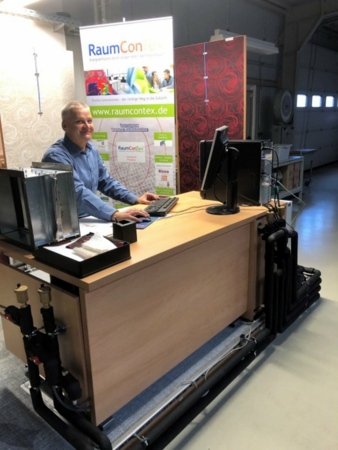09/01/2019 – Separtex — auf Deutsch lesen
What are textile networks good for?
Cooperation alliances between medium-sized companies and application-oriented research institutions create jobs and sustainable sales.
Since the beginning of this decade, Steffi Volland, Managing Director of textile and consulting company Luvo-Impex in Oelsnitz, Germany, has set up one tech-textiles network after another. SeparTex is now the 6th ZIM – a German, government sponsored innovation programme – to be launched between SMEs and institutes of applied research.
“In my view, you need two essential ‘ingredients’ for a new network to succeed in our Luvo association. The first is an innovative focus among the companies and institutions involved in the projects. The second ingredient is the ZIM programme which is sponsored by the German Federal Ministry for Economic Affairs and Energy without which we would not be able to create networks that aim to develop new products and processes. When these two elements come together and are united under a leading principle, we are then able to use the networks to open up new horizons beyond the borders of Saxony, creating new jobs, sustainable sales and strategic partnerships,” states Volland, adding: "Our textile companies in Saxony and Bavaria, some of which have been going for well over 100 years and have a huge amount of expertise, are currently undergoing fundamental structural change. They are recognising that ‘technical textiles’ are the future.”
Ideas do not fall from heaven
So how does a traditional weaving mill, an embroiderer, a knitter, a yarn spinner or – to be even more precise – a producer of net curtains – come to develop high-tech innovations and ideas that boost sales? Simply by working in one of the networks, be it InoReTex (until 2012), LanoTex (until 2014), RaumConTex (until 2016), InoEmTex (until 2017), UrbinTex (until 2019) or SeparTex (until 2020). This is where industry meets interdisciplinary science – moving far beyond the scope of textiles. Each of these networks usually has between 15 and 20 partners, including everything from construction firms and furniture makers to electronics companies. With most networks running for around three years, between 12 and 32 ZIM R+D funding applications are generally submitted for collaborations that ultimately lead to the creation of a prototype – these are perfect conditions for launching new, marketable products. Collaboration has so far cost almost EUR 26m, a good EUR 15m of which came from government funding. “We hope that this knowledge transfer can be translated into considerably higher sales in production fields that would have been unimaginable several years ago,” Volland continues.
Through close collaboration with science, the five completed networks alone have given rise to several dozen product innovations, allowing the traditional textile industry to explore completely new avenues. The products include, among others, climate furniture with textile heat exchangers, a modular system for reducing construction noise and dust, innovative wild boar deterrents and an affordable and quick diagnostic test strip made from textiles.
The ZIM SME network “Separtex” – for the development of textile-based carriers for active ingredients as well as system engineering for the separation of mixed substances – marks a new chapter in the future of high-tech textiles. These innovative separation textiles are expected to make a contribution to environmental protection and sustainability. Separtex launched in September 2018 initially with twelve partners and is currently looking for innovative partners involved in environmental technology and the textile supply chain. “These participants would ideally complement our planned focal topics,” states Volland, concluding, “We’re open to all enquiries and are happy to provide further details and information.”





